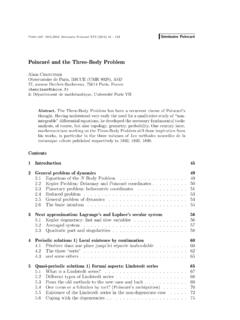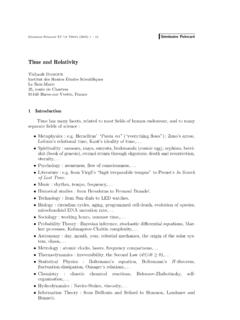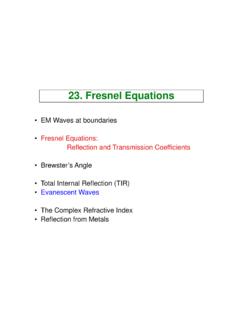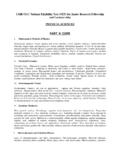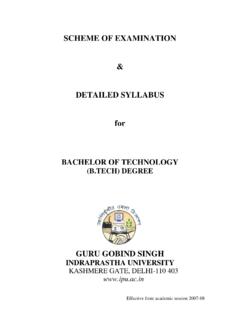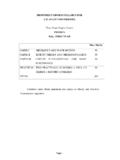Transcription of The Genesis of the Theory of Relativity
1 S eminairePoincar e 1 (2005)1 { 22S eminairePoincar eTheGenesisof theTheoryof RelativityOlivierDarrigolCNRS: Rehseis83,rueBroca75013 ParisThemostfamousof AlbertEinstein'spapersof 1905is undoubtedlytheoneconcerningthetheoryof Relativity . Any modernphysicistknowsthatthistheoryimpose sa strictandgeneralconstraint onthelawsof curiouslaymanwondersat thedaringreformof ourancestralconceptsof ,thetheoryofrelativity gave riseto rstof thismythis thatEinsteindiscoveredthetheoryof Relativity in a singlestrokeof geniusthatde esany Einstein'sreminiscencesfavor thisthesis,forinstancehisallusionto a conversationwithMicheleBessoin which he wouldhave suddenlyrealizedthata reformof theconceptof timesolved longstandingparadoxesof a deepinnovationis by de nitionimpossible,sincearadicallynewideac annotbe thecaseof Einstein'srelativity therarity of pre-1905sourcesfurtherdiscourageshistori calreconstruction.}
2 Andinvitesus to leave thismomentousdiscoveryin itsshroudof notappealto teachersof orderto convey somesortof logicalnecessity torelativity Theory , theyhave constructedanothermythfollowingwhich afewexperiments drove ,thefailureof ether-driftexperiments ledto therelativity principle;andtheMichelson-Morleyexperime nt ledto theconstancyof thevelocity of light; Einsteinonlyhadtocombinethesetwo principlestoderiverelativity counterpoiseto thismyth,thereis a third,idealistaccount in which Einsteinis supposedto have reachedhistheoryby a philosophicalcriticismof fundamentalconceptsin thespiritofDavidHumeandErnstMach, withouteven knowingabouttheMichelson-Morleyexperimen t, andwithoutworryingmuch aboutthetechnicalitiesof contemporaryphysicsin conscientioushistoriancannottrustsuch myths,even thoughtheymay containa hisconclusionsby reestablishingthecontextsin which Einsteinconductedhisre ections,by takingintoaccount hiseducationandformation,by introducingtheseveralactorswhosharedhisi nterests.
3 By identifyingthedi cultiestheyencounteredandthestepstheytoo kto solve thisprocess,hemustavoidthespeculative llingof gapsin rigidifyingany ill-foundedinterpretation,heshouldo eranopenspectrumofinterpretive hope to show in thispaper,thissober method allowsa fairintelligenceof theoriginsof rstindicationof theprimarycontextof theearlytheoryof Relativity is foundin theverytitleof Einstein'sfoundingpaper:\Ontheelectrodyn amicsof movingbodies."Thistitlechoicemay seembizarreto themodernreader,whode nesrelativity theoryas a theoryof withthelatterview,the rstsectionof Einstein'spaper dealswitha newkinematicsmeant to applyto any kindof of thepaper nonethelessdealswiththeapplicationof thiskinematicsto theelectrodynamicsandopticsof , Einsteinwantedto solve di cultieshe hadencounteredin thisdomainof surveyof physicsliteraturein theyears1895-1905showsthattheelectrodyna micsof movingbodiesthenwas a Einstein'spaper,severalstudieswithsimila rtitlesappearedin experimentalandtheoreticalworkwas beingdonein , o eredmutuallyincompatiblesolutions.
4 EminairePoincar esometimesdiagnoseda seriouscrisisin thisdomainof Hertz'sexperiments of 1887-8ontheelectricproductionof electromagneticwaves,Maxwell's eldtheorywas thenaturalframefordiscussingboththeelect rodynamicsandtheopticsof orderto understandtheevolutionof thissubject,onemust rstrealizethatthetheorythatMaxwello eredin histreatiseof 1873widelydi eredfromwhatisnow meant by \Maxwell'stheory."1 Maxwell'stheoryas it wasLike mostof hiscontemporaries,Maxwell regardedtheexistenceof theetheras a fundamentalandundeniablefactof electromagneticactions,which includedopticalphenomenain a phenomenologicaltheoryconcernedwiththema croscopicstatesof a continuousmedium,theether,which couldcombinewithmatterandshareitsvelocit yv.
5 Thesestateswerede nedby fourvectorsE,D,H,Bthatobeyeda fewgeneralpartialdi erentialequationsaswellassomerelationsde pendingontheintrinsicpropertiesof themostcompleteandconciseformlatergivenb y OliverHeavisideandHeinrich Hertz,thefundamentalequationsreadr E= DB=Dt ;r H=j+DD=Dtr D= ;r B= 0;(1)wherejis theconductioncurrent andD=Dtis theconvective derivative de nedbyD=Dt=@=@ r (v ) +v(r ):(2)In a linearmedium,the\forces"EandHwererelated to the\polarizations"DandBby therelationsD= EandB= H, andtheenergydensity (1=2)( E2+ H2) of themediumhadtheformof anelasticenergy. For Maxwellandhisfollowers,thechargedensity andtheconductioncurrentjwerenotprimitive concepts:theformercorrespondedto thelongitudinalgradient of thepolarizationor \displacement"D, andthelatterto thedissipative relaxationof thispolarizationin a thedisplacement constitutedanotherformofcurrent.
6 FollowingMichaelFaraday, Maxwell andhisdisciplesregardedtheelectric uidsof earliertheoriesas a na velysubstantialistnotion1 Theappearanceof theconvective derivativeD=Dtin Maxwell'stheoryderives fromhisun-derstandingof thepolarizationsDandBas statesof a singlemediummadeof etherandmatterandmovingwitha well-de nedvelocityv(thatmay varyfromplaceto place):thetimederivativesin thefundamentalequationsmustbe taken alongthetrajectoryof a given particleof of electromagneticinduction,r E= DB=Dt= @B=@t+r (v B);(3)containsthe(v B) contributionto theelectric eldin theorem,it leadsto theexpressionIE dl= ddtZ ZB dS(4)of Faraday'slaw of induction,whereintheintegrationsurfacemo ves eldis causedby a magnet,themagnetic uxonlydependsontherelative positionof themagnetandthecircuitso thattheinducedcurrent onlydependsontheirrelative sum,theconceptualbasisof Maxwell'soriginaltheorywidelydi eredfromwhattoday' andmagnetismwere eld-derivedconcept, ,A treatiseonelectricityandmagnetism, 2 vols.
7 (Oxford,1973); ,\ Uber dieGrund-gleichungenderElektrodynamikf ur bewegteK orper,"AnnalenderPhysik, 41 (1890), , 2005 TheGenesisof theTheoryof Relativity3electromagnetismtreatsthemas quasi-materialetherwas (1)onlycorrespondto our\Maxwell equations"in thecaseof bodiesat rest,forwhich thevelocityvis zeroandtheconvective derivativeD=Dtreducesto thepartialderiva-tive@ Onethinghasnotchanged,however:thetheory' sability to a homogenousinsulatorat rest,Maxwell'sequationsimplytheexistence of transversewaves propagatingat thevelocityc= 1=p . Havingfoundthiselectromagneticconstant to beverycloseto thevelocity of light, Maxwellidenti edthesewaves withlight ,elastic-solidtheoriesof fewyearsafterMaxwell'sdeath(in1879),a growingnumber of Britishphysicistssalutedthisachievement andcameto regardMaxwell'stheoryas philosophicallyandpracticallysuperiorto electricity andmagnetism,basedonelectricandmagnetic uids(orAmpereancurrents)
8 Directlyactingat a 'stheoryuntil in 1888 Heinrich Hertzdemonstratedtheemissionof electromagneticwaves by a rmed,agrowingnumber of physicistsadoptedMaxwell'stheoryin a moreor lessmodi thistheorywas notwithoutdi hadhimselfnotedthathisphenomeno-logicala pproach ledto wrongpredictionswhenappliedto opticaldispersion,to magneto-optics,andto theopticsof thesecaseshesuspectedthatthemolecularstr uctureofmatterhadto be taken into : Theopticsof movingbodiesMaxwell'sideaof a singlemediummadeof etherandmatterimpliedthattheetherwasfull ydraggedby movingmatter, movingcircuitsandmagnets,it was problematicin therealmof rstdi culty concernedtheaberrationof stars,discoveredby theBritishastronomerJamesBradleyin 1728:thedirectionof observationof a xedstarappearsto varyperiodicallyin thecourseof ayear,by anamount of thesameorderas theratio(10 4) of theorbitalvelocity of theearthto thevelocity of light simplyexplainedthise ectby thefactthattheapparentvelocity of a light particleis thevectorsumof itstruevelocity andthevelocity of theearth( ).
9 In theearlynineteenth century, thefoundersof thewave theoryof light ThomasYoungandAugustinFresnelsavedthisex planationby assumingthattheetherwas completelyundisturbedby themotionof theearththroughit. Indeed,rectilinearpropagationat constant velocity is allthatis 'sassumptionimpliedanetherwindof theorderof 30km/sontheearth'ssurface,fromwhich a minutemodi cationof thelawsof opticalrefractionought to follow. AsFresnelknew,anearlierexperiment of hisfriendFran coisAragohadshownthatrefractionby a prismwas infactuna ectedby theearth' notAragohadreachedthenecessaryprecisiono f 10 4, Fresneltookthisresultseriouslyandaccount edforit by meansof a partialdraggingof explainedas Fermat'sprinciple,thetrajectorythatlight takes totravelbetweentwo xedpoints (withrespecttotheearth)is thatforwhich thetravelingtimeis aminimum,whetherthemediumof propagationis at restor of light withrespectto theetherin a substanceof opticalindexnisc=n, ifcdenotesthevelocity of light.
10 Theabsolutevelocity of theetheracrossthissubstanceis u, where is thedraggingcoe cient anduis theabsolutevelocity of thesubstance(theabsolutevelocity beingthatwithrespectto theremote,undisturbed partsof theether).Therefore,thevelocity of light alongtheelementdlof an arbitrary2J. Bradley, \Anewapparent motiondiscoveredin the xedstars;itscauseassigned;thevelocity andequablemotionof light deduced,"Royal Society of London,Proceedings, 35 (1728), ,\Lettred'AugustinFresnel a Fran coisAragosurl'in uencedumouvement terrestredansquelquesph enom enesd'optique,"Annalesde chimieet de physique, 9(1818),alsoinOeuvres compl etes, Paris(1868), , eminairePoincar eFigure 1 a xed starin theskyis judged by theorientationof a narrowstraighttube throughwhichit canbe theearthis movingwithrespect to the xed starsat thevelocityu, thelattersweepsthedistanceu duringthetime thatthelightfromthestartakesto travelfromthebeginningto theendof thetube.


